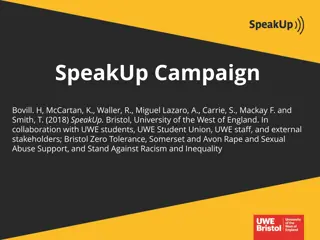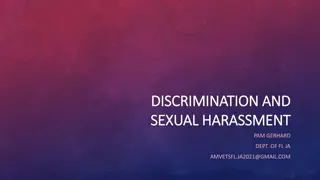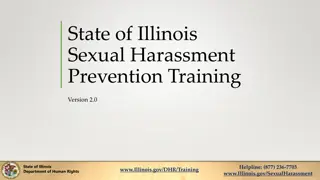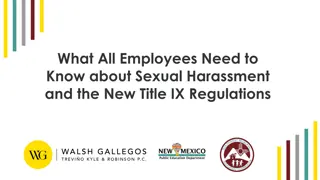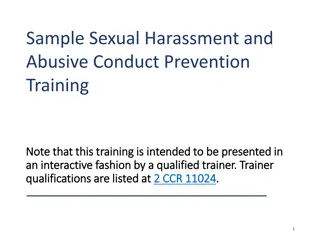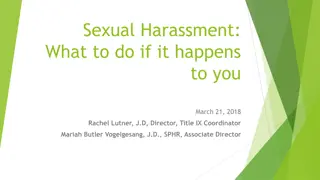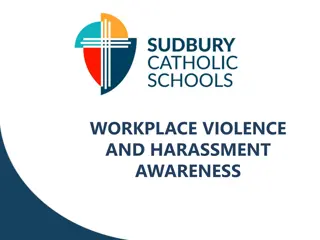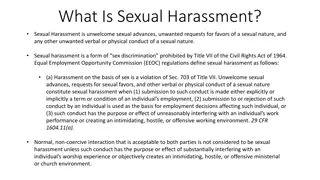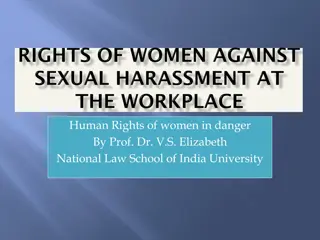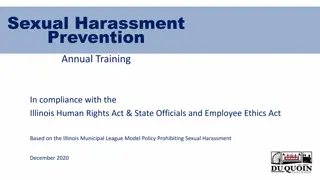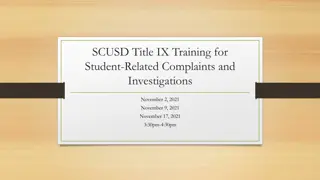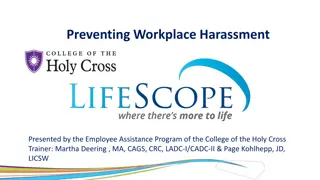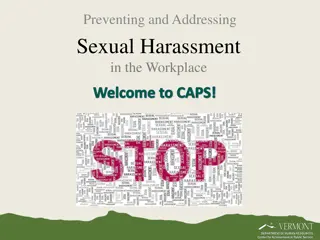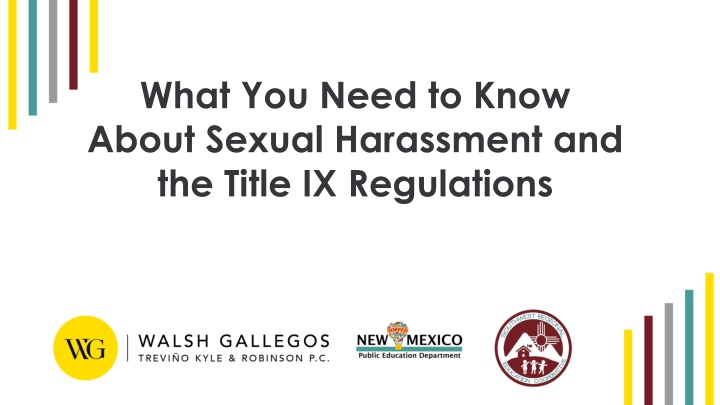
Title IX Regulations and Sexual Harassment Impact
Learn about Title IX regulations and the impact of sexual harassment, including recent changes, coordinator responsibilities, and the types of conduct defined under the regulations. Stay informed to ensure compliance and address issues effectively.
Uploaded on | 0 Views
Download Presentation

Please find below an Image/Link to download the presentation.
The content on the website is provided AS IS for your information and personal use only. It may not be sold, licensed, or shared on other websites without obtaining consent from the author. If you encounter any issues during the download, it is possible that the publisher has removed the file from their server.
You are allowed to download the files provided on this website for personal or commercial use, subject to the condition that they are used lawfully. All files are the property of their respective owners.
The content on the website is provided AS IS for your information and personal use only. It may not be sold, licensed, or shared on other websites without obtaining consent from the author.
E N D
Presentation Transcript
What You Need to Know About Sexual Harassment and the Title IX Regulations
What is Title IX? Title IX of the Education Amendments of 1972 The law says: No person in the United States shall, on the basis of sex, be excluded from participation in, be denied the benefits of, or be subjected to discrimination under any education program or activity receiving Federal financial assistance. Sexual harassment is a form of sex discrimination. This has been established in the law for a long time. Formal federal guidance on compliance with Title IX as it relates to sexual harassment has been limited, until 2020. There had been no official regulations addressing sexual harassment or school response obligations. Instead, guidance has come from court cases and Dear Colleague letters issued by the US Department of Education (DOE).
New Regulations In May of 2020, the Department of Education adopted new regulations governing a school s response to sexual harassment. Effective date was August 14, 2020.
Some Highlights of Those Regulations New Title IX Coordinator Responsibilities. New roles that cannot be held by the same individuals. Narrow Definition of Sexual Harassment. New standard for when the district knows about the conduct. District responsibility to respond to what it knows. New Formal Complaint process. Special Education considerations.
Title IX Coordinator Each district must have one, must identify this person as the Title IX Coordinator, and must make their contact information public (on the web site, in policy, etc.). There can be more than one. They must have authority to coordinate a district s efforts to comply with its responsibilities under Title IX. The Title IX Coordinator also has newly defined responsibilities. One of the main responsibilities: making contact with a Complainant after a report of possible sexual harassment is made, and initiating and coordinating the district s response to that reported conduct.
Sexual Harassment Under the Regulations There are three types of conduct, on the basis of sex, that constitute sexual harassment, but only if the school had substantial control over both the harasser and the context in which the sexual harassment occurred. Quid pro quo by an employee Hostile environment: Unwelcome conduct that is so severe, pervasive and objectively offensive that it effectively denies the person access to an education program or activity. Conduct that meets the definition for sexual assault, dating violence, domestic violence, and stalking under federal law.
A Word About Substantial Control Under the Title IX rules, the District does not have any authority over the alleged sexual misconduct if it did not have substantial control over the harasser and the context. in which the harassment occurred. That means the alleged harasser has to have attended school or worked for the District at the time of the conduct alleged AND The alleged conduct had to have occurred in a context over which the district or school has control or authority. For example, at school, at District sponsored or promoted events or activities. But not, for example, necessarily at a private party over the weekend, at Sonic, or online during the evening. BUT, BUT, other state or District conduct rules may apply cyberbullying or ethical misconduct for instance.
Defining Quid Pro Quo Quid pro quo: When an employee conditions favorable treatment on the acceptance of unwelcome sexual attention. This definition applies only to actions of employees. Teacher offers good grades to student in exchange for .. Maintenance Director offers a promotion or better pay in exchange for ..
Defining Hostile Environment Conduct that it is so severe, pervasive, AND effectively denies a person equal access to the school s programs. AND objectively offensive that it This could be student-to-student conduct, employee-to-student conduct, or employee-to-employee conduct. Again, a lot of things happen in schools that are inappropriate and sexually oriented, but fall short of this definition. They can be addressed under other policies.
Defining Sexual Harassment Under Certain Federal Law The federal Clery Act and the Violence Against Women Act (VAWA) address four types of violence that are each considered forms of sexual harassment under Title IX: Sexual assault: Forcible or non-forcible sexual offenses under the Uniform Crime Reporting System of the FBI. Dating violence: Violence done by a person who is, or has been, in a dating relationship with the other person. Domestic violence: Violence by a current or former intimate partner. Stalking: A course of conduct directed at a specific person that would cause a reasonable person to fear for personal safety of self or others; or to suffer emotional distress. These would also be alleged criminal conduct so law enforcement or CYFD should be notified.
Terminology Complainant Complainant = individual who was allegedly sexually harassed Respondent Respondent = person accused of sexual harassment Report vs. Formal Complaint Report vs. Formal Complaint = report can be verbal or written, can be made by anyone; a formal complaint may only be made by the Complainant or Title IX Coordinator and must be a signed writing. Supportive Measures Supportive Measures = individualized non-disciplinary, non-punitive services Actual Knowledge Actual Knowledge = when any employee has knowledge of potential sexual harassment Education program or activity = Education program or activity = any academic, extracurricular, vocational or other education program operated by a district 14
Complainant This term always refers to the individual who was allegedly sexual harassed, even if someone else is the one who made the report of sexual harassment. Custodian reports that Student is being harassed. Custodian has made the report, but Student is the Complainant. Teacher reports that colleague is being harassed. Teacher makes the report, but the colleague is the Complainant. 15
Respondent This term refers to the person accused of sexual harassment. Note: these terms (Complainant, Respondent) apply even when there is a Report, but no Formal Complaint. Example: Mom complains that Billy is being harassed by a coach based on his sex. The Title IX Coordinator meets with mom and explains the Formal Complaint process. Mom does not want that, and Title IX Coordinator also decides not to initiate Formal Complaint process. There is a Report here, but no Formal Complaint. Billy is still the Complainant and Coach is the Respondent. 16
Supportive Measures Supportive Measures = Supportive Measures = Non-disciplinary, non-punitive individualized services offered to Complainant and Respondent at no charge. Must be designed to restore or preserve equal access to the education program or activity without unreasonably burdening the other party whether or not a formal complaint is filed. Examples: Examples: Counseling. Mutual restrictions on contact. Modification of schedule(s). Campus escort services. 17
Admin Leave and Emergency Removal The Title IX regulations allow a non-Student Employee to be placed on Administrative Leave while a Title IX review or formal complaint process is pending. A respondent student can also be removed on an emergency basis, BUT there is a high bar to so, and and if the student has a disability, the manifestation determination must also take place. To make an emergency removal of a respondent student, the District must undertake[] an individualized safety and risk analysis, determine[] that an immediate threat to the physical health or safety of any student or other individual immediate threat to the physical health or safety of any student or other individual arising from the allegations of sexual harassment arising from the allegations of sexual harassment justifies removal, and provide[] the respondent with notice and an opportunity to challenge the decision immediately following the removal. an 18
What does actual knowledge mean? This term is important for all staff. Why? Because the school s legal duty to respond arises when it has actual knowledge of sexual harassment, or of allegations of conduct that, if true, would constitute sexual harassment. Under Title IX regulations, the district/school has actual knowledge when any any employee of the school other than the perpetrator of the harassment has actual knowledge. This is new: Previously, actual knowledge was imputed to the school only when it was known by someone who had the authority to address it. any employee is aware of the conduct. Now, it is if any 19
This means District should train all employees All employees are potential reporters and must must report. Volunteers and contractors are NOT mandatory reporters under the rules, but can be provided training and given the expectation to report. Districts should train ALL employees this responsibility. If you do not use an outside trainer, then the Title IX Coordinator is likely going to be tasked with this training. ALL employees on 20
Is there actual knowledge? A. A fellow teacher and drinking buddy confides in another teacher that he s been fooling around with a student. He makes sure she gets an A and a college recommendation. B. Custodian witnesses an act of sexual harassment between students in the bathroom after school. C. A teacher s aide confides in another aide about something that happened on the school field trip. All three of these are examples of situations that, in the past, did not put the All three of these are examples of situations that, in the past, did not put the school on notice of actual knowledge. Now they do. school on notice of actual knowledge. Now they do. 21
Why the Change? DOE notes that with young children in K-12 schools, an adult is an adult. K-12 students may not understand the distinctions between a para and a teacher, for example. Regulation expanded to put the school on notice if any employee has actual knowledge. The standard for actual knowledge at the post-secondary level remains as it was someone with authority to take corrective action. any 22
What does substantial control mean? Under Title IX, the school is not responsible for responding to allegations of sexual harassment unless the school had substantial control over both the harasser and the context in which the conduct occurred. Consider how this will be applied to: extracurricular activities; field trips; out of town, overnight trips; staff happy hours; cyberbullying off campus. Scenario: Student engages in electronic sexual harassment off campus and on the weekend. Does the school have substantial control ? What about state law which gives schools the authority to discipline students for certain off campus cyberbullying?
Key Roles Outlined in Regulations Title IX Coordinator Investigator Decision Maker (Optional) Informal Resolution Facilitator Appeals Decision Maker NOTE: all of these roles must be filled by individuals trained in Title IX and only the Title IX Coordinator/Investigator roles can be filled by the same person. These positions can be contractors or other non-District personnel (e.g. REC staff or those from a nearby District)
Overview The Title IX Coordinator coordinates the district s efforts to comply with Title IX of the Education Amendments of 1972. The regulations significantly expand and change the role and responsibilities of the Title IX Coordinator with regard to dissemination of information, training, setting standards, and handling reports and conducting investigations of alleged sexual harassment or other sexual misconduct. 26
Role of Title IX Coordinator Overview Every district must have at least one designated as and identified as the Title IX Coordinator . at least one, and that person must be Must have authority to coordinate the school district s compliance efforts. May investigate complaints, but may not be the decision maker. Must be referred to as the Title IX Coordinator in district policies and publications, including website. all potential reporters of sexual misconduct of the Title IX Coordinator s contact information: name/title, office and email addresses, and telephone number. A district must notify all potential reporters 27
Role of Title IX Coordinator Overview There must be a district wide Title IX Coordinator, but subordinate Title IX Coordinators could also be designated at the individual campus level to assist with responding to reports of sexual harassment. Remember: the Title IX Coordinator has specific responsibilities and authority in the report and formal complaint process. 28




